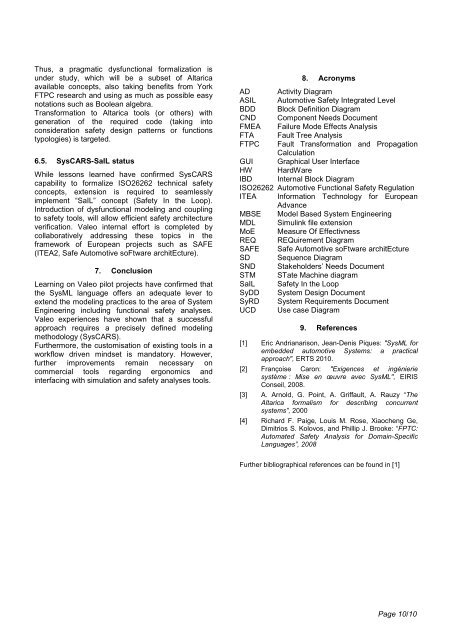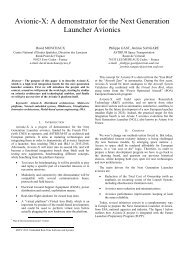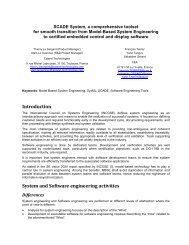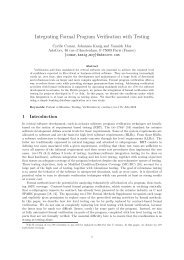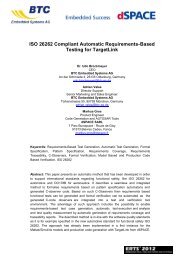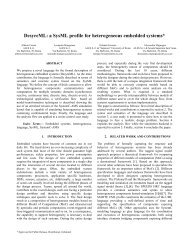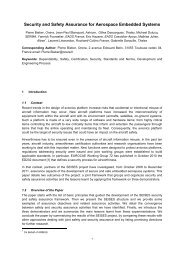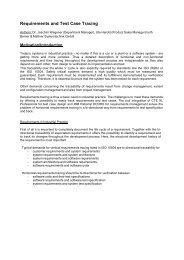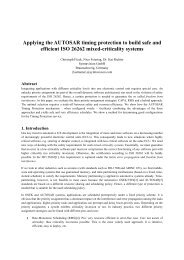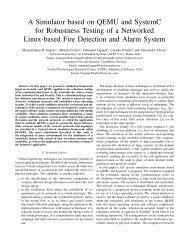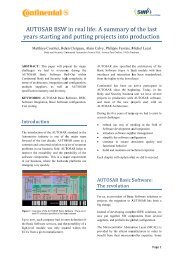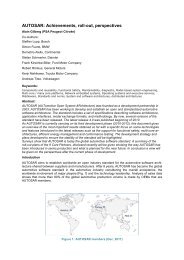SysML for embedded automotive Systems: lessons learned
SysML for embedded automotive Systems: lessons learned
SysML for embedded automotive Systems: lessons learned
Create successful ePaper yourself
Turn your PDF publications into a flip-book with our unique Google optimized e-Paper software.
Thus, a pragmatic dysfunctional <strong>for</strong>malization is<br />
under study, which will be a subset of Altarica<br />
available concepts, also taking benefits from York<br />
FTPC research and using as much as possible easy<br />
notations such as Boolean algebra.<br />
Trans<strong>for</strong>mation to Altarica tools (or others) with<br />
generation of the required code (taking into<br />
consideration safety design patterns or functions<br />
typologies) is targeted.<br />
6.5. SysCARS-SaIL status<br />
While <strong>lessons</strong> <strong>learned</strong> have confirmed SysCARS<br />
capability to <strong>for</strong>malize ISO26262 technical safety<br />
concepts, extension is required to seamlessly<br />
implement “SaIL” concept (Safety In the Loop).<br />
Introduction of dysfunctional modeling and coupling<br />
to safety tools, will allow efficient safety architecture<br />
verification. Valeo internal ef<strong>for</strong>t is completed by<br />
collaboratively addressing these topics in the<br />
framework of European projects such as SAFE<br />
(ITEA2, Safe Automotive soFtware architEcture).<br />
7. Conclusion<br />
Learning on Valeo pilot projects have confirmed that<br />
the <strong>SysML</strong> language offers an adequate lever to<br />
extend the modeling practices to the area of System<br />
Engineering including functional safety analyses.<br />
Valeo experiences have shown that a successful<br />
approach requires a precisely defined modeling<br />
methodology (SysCARS).<br />
Furthermore, the customisation of existing tools in a<br />
workflow driven mindset is mandatory. However,<br />
further improvements remain necessary on<br />
commercial tools regarding ergonomics and<br />
interfacing with simulation and safety analyses tools.<br />
8. Acronyms<br />
AD Activity Diagram<br />
ASIL Automotive Safety Integrated Level<br />
BDD Block Definition Diagram<br />
CND Component Needs Document<br />
FMEA Failure Mode Effects Analysis<br />
FTA Fault Tree Analysis<br />
FTPC Fault Trans<strong>for</strong>mation and Propagation<br />
Calculation<br />
GUI Graphical User Interface<br />
HW HardWare<br />
IBD Internal Block Diagram<br />
ISO26262 Automotive Functional Safety Regulation<br />
ITEA In<strong>for</strong>mation Technology <strong>for</strong> European<br />
Advance<br />
MBSE Model Based System Engineering<br />
MDL Simulink file extension<br />
MoE Measure Of Effectivness<br />
REQ REQuirement Diagram<br />
SAFE Safe Automotive soFtware architEcture<br />
SD Sequence Diagram<br />
SND Stakeholders’ Needs Document<br />
STM STate Machine diagram<br />
SaIL Safety In the Loop<br />
SyDD System Design Document<br />
SyRD System Requirements Document<br />
UCD Use case Diagram<br />
9. References<br />
[1] Eric Andrianarison, Jean-Denis Piques: "<strong>SysML</strong> <strong>for</strong><br />
<strong>embedded</strong> <strong>automotive</strong> <strong>Systems</strong>: a practical<br />
approach", ERTS 2010.<br />
[2] Françoise Caron: "Exigences et ingénierie<br />
système : Mise en œuvre avec <strong>SysML</strong>", EIRIS<br />
Conseil, 2008.<br />
[3] A. Arnold, G. Point, A. Griffault, A. Rauzy “The<br />
Altarica <strong>for</strong>malism <strong>for</strong> describing concurrent<br />
systems”, 2000<br />
[4] Richard F. Paige, Louis M. Rose, Xiaocheng Ge,<br />
Dimitrios S. Kolovos, and Phillip J. Brooke: “FPTC:<br />
Automated Safety Analysis <strong>for</strong> Domain-Specific<br />
Languages”, 2008<br />
Further bibliographical references can be found in [1]<br />
Page 10/10


